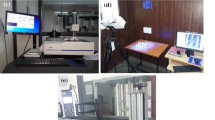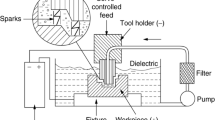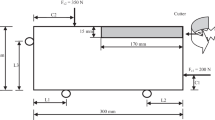Abstract
In an advanced manufacturing system, accurate assessment of tool life estimation is very essential for optimising the cutting performance in turning operations. Estimation of tool life generally requires considerable time and material and hence it is a relatively expensive procedure. In this present work, back-propagation feed forward artificial neural network (ANN) has been used for tool life prediction. Speed, feed, depth of cut and flank wear were taken as input parameters and tool life as an output parameter. Twenty-five patterns were used for training the network. Recently there have been significant research efforts to apply evolutionary computational techniques for determining the network weights. Hence an evolutionary technique named particle swarm optimisation has been used instead of a back-propagation algorithm and it is proven that the experimental results matched well with the values predicted by both artificial neural network with back-propagation and the proposed method. It is found that the computational time is greatly reduced by this method .
Similar content being viewed by others
References
Montgomery DC (1984) Design and analysis of experiments. Wiley, New York
Box GEP (1986) Studies in quality improvement, Technical report. Centre for quality and productivity improvement. University of Wisconsin
Taylor FW (1906) On the art of cutting metals. Trans ASME 28:31
Wu SM (1964) Tool life testing by response surface methodology, Part I. Trans A.S.M.E., J Eng Ind 86:105–116
Wu SM (1964) Tool life testing by response surface methodology, Part II. Trans A.S.M.E., J Eng Ind 86:111–115
Choudhury SK et al. (1999) On line monitoring of too l wear in turning using a neural network. Int J Mach Tools Manuf 39:489–504
Das S et al. (1996) Evaluation of wear of turning carbide inserts using neural networks. Int J Mach Tools Manuf 36(7):789–797
Dornfield DA (1990) Neural network sensor fusion for tool condition monitoring. Ann CIRP 39(1):1
Das S et al. (1997) Simple approach for online tool monitoring using the analytical hierarchy process. Proc Institution of Mechanical Engineers, Part B. J Eng Manuf 211:19–27
Das S et al. (1997) Neural networks based tool wear monitoring in turning medium carbon using a coated carbide tool. J Mater Process Technol 63:187–192
Tetsutaro et al. U (1986) Prediction and detection of cutting tool failure by modified group method of data handling. Int J Mach Tools Manuf 26:233–245
Suresh PVS et al. (2002) A genetic algorithmic approach for optimisation of surface roughness prediction model. Int J Mach Tools Manuf 42:675–680
Saravanan R et al. (2003) Machining parameters optimisation for turning cylindrical stock into a continuous finished profile using a genetic algorithm and simulated annealing. Int J Adv Manuf Technol 21:1–9
Kennedy J, Eberhart RC (1995) Particle swarm optimisation. Proc IEEE International Conference on Neural Networks IV, pp 1942–1948
Purushothaman S, Srinivasa YG (1994) A back propagation algorithm applied to tool wear monitoring. Int J Mach Tools Manuf 34(5):625–631
Rajasekaran S, Vijayalakshmi Pai GA (1996) Genetic algorithm based weight determination for back-propagation networks. Proc Fourth International Conference on Advanced Computing, pp 73–79
Eberhart RC, Shi Y (1998) Comparison between genetic algorithms and particle swarm optimisation. The 7th Annual Conference on Evolutionary Programming, San Diego, CA, USA
Author information
Authors and Affiliations
Corresponding author
Additional information
An erratum to this article is available at http://dx.doi.org/10.1007/s00170-017-0135-2.
Rights and permissions
About this article
Cite this article
Natarajan, U., Periasamy, V. & Saravanan, R. Application of particle swarm optimisation in artificial neural network for the prediction of tool life. Int J Adv Manuf Technol 28, 1084–1088 (2006). https://doi.org/10.1007/s00170-004-2460-5
Received:
Accepted:
Published:
Issue Date:
DOI: https://doi.org/10.1007/s00170-004-2460-5




